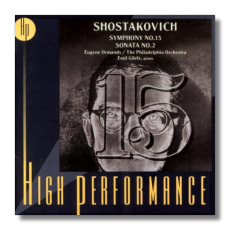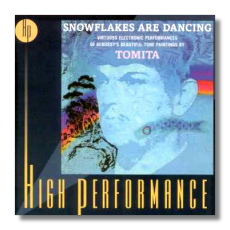
The Internet's Premier Classical Music Source
Related Links
- Latest Reviews
- More Reviews
-
By Composer
-
Collections
DVD & Blu-ray
Books
Concert Reviews
Articles/Interviews
Software
Audio
Search Amazon
Recommended Links
Site News
 CD Review
CD Review
RCA High Performance II

Dmitri Shostakovich
- Symphony #15
- Piano Sonata #2
Emil Gilels, piano
Philadelphia Orchestra/Eugene Ormandy
RCA High Performance 09026-63587-2 ADD 72:06


Claude Debussy (arr. Tomita)
- Snowflakes Are Dancing
Isao Tomita, electronics
RCA High Performance 09026-63588-2 ADD 51:53


- Piotr Ilyitch Tchaikovsky: Violin Concerto
- Jean Sibelius: Violin Concerto
- Antonín Dvořák: Romance
Itzhak Perlman, violin
Boston Symphony Orchestra/Erich Leinsdorf
RCA High Performance 09026-63591-2 ADD 75:08
BMG Classics' High Performance series crosses the dozen mark with these three releases. The series, which is about a year old, features recordings which met high performance and recording standards from the Living Stereo era up until the dawn of the digital age. Many are new to CD. Even those that aren't new benefit from the superb frequency range, sampling rate, and CD mastering technology that has been used in bringing these discs to the market.
Eugene Ormandy recorded several of Shostakovich's symphonies for Sony (then Columbia Masterworks) and RCA Victor – all are strongly recommendable. In my opinion, the Fifteenth hasn't been surpassed. Ormandy recorded it in 1972, just a few days after he and the Philadelphians gave the symphony's American première. It's a highly atmospheric reading, dark and warm, and a very appropriate leave-taking. This was Shostakovich's last symphony, and no one has treated it as tenderly as Ormandy has. That's not to say that this recording lacks penetration – anything but. Its compassionate nature can't help but deeply touch everyone who experiences it. I disagree with Ormandy's "take" on this score, as expressed in the original program notes. Could he really have believed that the first movement "takes place in a toy shop at night," as the official Soviet explanation averred? Shostakovich kept his secrets, and this sounds like disinformation at its finest. Nevertheless, Ormandy hits the mood right on, which only supports my assertion that great music-making is frequently not an intellectual process but an instinctual one.
Emil Gilels recorded the Second Piano Sonata in 1965; the location was Carnegie Hall. This is another valuable addition to the High Performance series. Gilels creates an uncanny effect through understatement, and the clarity of his playing generates a tension that is more palpable than anything that would have resulted from the exaggeration of details. If you want the Sonata on disc, this should be your top choice. The sound quality is a bit less fine here than in the symphony; it can sound a little harsh, but it's not worrisome.
The Tomita disc really took me down Memory Lane. I owned most of the Japanese electronics wizard's LPs when I was in high school, although I began to get tired of them when I was in college. I don't think I've heard one in 15 years. It was fun to revisit Snowflakes Are Dancing, which was Tomita's first American release. Debussy wrote these ten short works for the piano. Some were meant to be played on their own, and others as part of a larger collection of music. Debussy mastered the piano and all of its colors so well that it was daring of Tomita to arrange this music for a synthesizer and other electronic gizmos. Of course it will shock purists. Debussy's music is the hanger upon which Tomita drapes a universe of sounds. Some of the sounds are silly, but most of them are delicate and beautiful. They're almost always exotic. Tomita doesn't bury his Japanese background, and Debussy's music is characterized by an Asian economy and sensitivity to nuance, so the combination of the two styles works very well. An inevitable air of "easy listening" blows in from time to time, but it is more likely to make you smile than to wrinkle your nose. Prélude to the Afternoon of a Faun has been added from another Tomita album, and it paints with an even more remarkable palette of sounds. In a sense, it is a bit odd to refer to an album of electronic music as "audiophile" because such music really wasn't intended to be performed in a concert space, and no one knows what it is "supposed" to sound like. Having said that, the clarity, dynamic range, and frequency response of this 96 kHz, 24-bit remastering are amazing. The original LPs could not begin to produce the musical information made available on this CD.
Itzhak Perlman's technically impressive 1966 debut with RCA Victor was with the Sibelius concerto; the Tchaikovsky came a year later. Although the Sibelius's finale is exciting, Perlman and Leinsdorf had a lot of competition then, and they have even more today, including the outstanding Perlman and Previn recording on EMI Classics. At this point in his career, Perlman conquered listeners with his tone and youthful passion, but he varies neither of these very much in the Sibelius concerto, and a somewhat monochromatic rendition is the result. The Tchaikovsky is better, particularly because Perlman and Leinsdorf open the traditional cuts, to the benefit of the music's structure. Nevertheless, Perlman is not imaginative, and, as I wrote in another publication, "those who associate the concerto's first movement with Russian nobility might be a little disappointed to hear more of the Israeli kibbutz instead." In contrast, the Dvořák is entirely successful – relaxed and full of song. When these recordings were made, Perlman's interpretive maturity was not as developed as his technique. That would soon change, and these recordings are full of promise, not necessarily delivery. The glassiness of earlier CD transfers has been corrected in this High Performance remastering.
Copyright © 2000, Raymond Tuttle


















